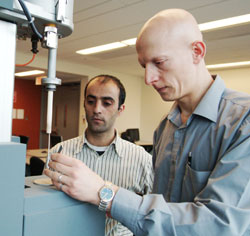Developing improved fuel efficiency

Mamoun Medraj (right) with Mohammed Aljarrah, who also is researching the potential of magnesium alloys.
Photo by Kate Hutchinson
Mamoun Medraj (Mechanical and Industrial Engineering) and his team of graduate students are attracting attention from some pretty impressive quarters.
“BMW was very interested in our work on a magnesium-aluminum-strontium alloy system. We met twice, but they had no corporate mechanism for investing in research outside of Germany.”
Medraj’s research focuses on the development of lightweight alloys for use in the automotive and aerospace industries. “Our work doesn’t make front page news, but it is very important to the transportation sector.” The ultimate goal is improved fuel efficiency.
The more weight an engine has to move, the more fuel it requires. And, as Medraj pointed out, it’s not a proportional relationship. Small increases in weight require much more fuel, so conversely, “even taking 10 kilograms off a vehicle can result in significant savings.”
Unfortunately, lighter-weight vehicles can also be less safe, so the question is where and how to reduce the weight.
Medraj and his team are looking very closely at magnesium alloys. Magnesium is lighter than aluminum and steel (the two primary metals used for current vehicle construction), has high specific strength and good castability. It also, unfortunately, has less desirable thermal properties, making it unusable — for the moment — in engine components.
But it’s the potential that drives Medraj’s research. “Right now, our
understanding and ability to use magnesium is where aluminum was 50 years ago.”
The alloys and processes he and his team are developing are completely new and
of interest to both the automotive and aerospace industries.
They have
undertaken and continue to pursue projects in collaboration with the Consortium
de recherche et d’innovation en aérospatiale au Québec (CRIAQ), the Aerospace
Manufacturing Technology Center (AMTC), the CANMET Materials Technology
Laboratory, IMI and Pratt and Whitney Canada.
One AMTC project examined the use of laser welding for magnesium alloys. “Here you can get a significant weight reduction,” Medraj explained, “but we had to figure out how to join dissimilar materials together.” This resulted in the development of a software package which helps determine how to end up with a sound joint over changing shapes and materials that can be used for many applications, not just simple flat joints.
It was precisely this expertise that took Medraj (and department colleague Suong Hoa) to India last year (see Journal, Jan. 11, 2007). “I was lucky to go,” he said. “I got to meet many people.”
The mission was, in part, a means of ensuring future collaboration, as opposed to competition, between Quebec and Indian institutions. Medraj has already heard from a number of the contacts he made.
“They are very interested in working together. We expect things to happen,
and these initial contacts will be the first to move forward.”
In the
meantime, Medraj continues to focus on his research here, and is involved in a
new U.S.-Canada-China initiative to replace the large structural components
between the engine and dashboard in cars with magnesium alloys.
He will be helped in this research by a new piece of equipment. Last year, Anwar Perez, a research assistant in Medraj’s lab, found out that Rhodia Inc., an international chemical company with North American headquarters in Cranbury, N.J., was looking to donate a scanning electron microscope (SEM) to a university.
“They actually wanted to give it to a US institution, but then they discovered that the wife of one of their engineers was a Concordia grad,” and that sealed the deal; the SEM is now sitting in his lab. The new piece of equipment will allow Medraj and his team to get a really close look at the materials they work with “to obtain high magnification images of the microstructure and chemical composition.”
“It’s very important to the research,” he said. “It took a while to install, but it will definitely move things forward.”
Medraj, one of Concordia’s up-and-coming researchers, joined the faculty in 2002 after completing a postdoc at McGill. Since then, he has established an enviable research and teaching portfolio. His proudest achievement to date is seeing eight graduate students through to a degree.
“They have all either found good jobs in the industry or are pursuing further studies at well-respected universities.”